Note: This website was automatically translated, so some terms or nuances may not be completely accurate.
How Should CMOs Approach Digital? — People and Brand Session
In 2015, the author wrote a series of columns for CMOs (Chief Marketing Officers), marketing department heads, and brand managers (hereafter referred to as "CMOs, etc.") who were struggling with "how to engage with digital."
Brand Growth Hacking: New "Marketing × IT" Methods Guaranteeing Business Growth
Three years have passed since that series, and as the digital environment has significantly evolved, we present a new, further refined series.
<Table of Contents>
▼I Enhancing Marketing Capabilities Through Digital-Human "Sessions"
▼II The CMO's Role: "Overall Optimization" and "Creating an Environment for Innovation"
▼III Four Key Areas to Drive Overall Optimization and Innovation
▼IV Brand Building in the Digital Age: The "Why Model"
Ⅰ Enhancing Marketing Capabilities Through Digital and Human "Sessions"
Starting with big data around 2012 and expanding to recent advancements like location data, payment data, IoT, AI, voice devices, and AR/VR/MR (※1), digital marketing leveraging data and cutting-edge technology continues to grow in importance.
We now live in an era where diverse data on targets and customers is abundant, enabling its utilization to deepen customer understanding (※2).
※1 Mixed Reality.
In response to this situation, Dentsu Inc. is promoting a new marketing framework centered on "people": " People Driven Marketing ".
Amidst this, digital utilization is no longer solely the domain of digital advertising operations staff or IT department personnel. It has become a theme that no one involved in marketing or advertising as a whole—including the CMO—can afford to ignore.
I often work with CMOs and other executives from various clients, and a recurring topic of discussion is the challenge of "how to engage with digital" – specifically, determining "what to delegate to digital or digital specialists, and what requires personal consideration and decision-making?"
This series will explain how "digital" and "people" should interact, their division of roles, and the interplay between "human hypothesis building" and "data-driven verification," using the term " " sessions.
II. The CMO's Role: "Overall Optimization" and "Creating an Environment for Innovation"
In the digital age, the primary focus for CMOs and others should be the "overall optimization" of marketing.
The author frequently receives consultations regarding digital initiatives like the following:
"We implemented digital advertising campaigns and embedded video content showcasing our products/services from various angles on our company website. We also introduced marketing automation tools to convert prospects into customers. However, these digital initiatives remain isolated efforts, operating in a state of 'individual optimization' without integration, which is causing problems."
"Is it possible to holistically optimize our digital initiatives to further increase customers and boost sales?"
I refer to this state where multiple digital initiatives are individually optimized in isolation as the "frog-in-the-well syndrome." In truth, this phenomenon is somewhat unavoidable.
The reason is that technological advancements in each field are incredibly rapid, leaving digital managers on the front lines overwhelmed just keeping up and managing daily operations. Consequently, they lack the capacity to integrate these efforts, leading to individual optimization.
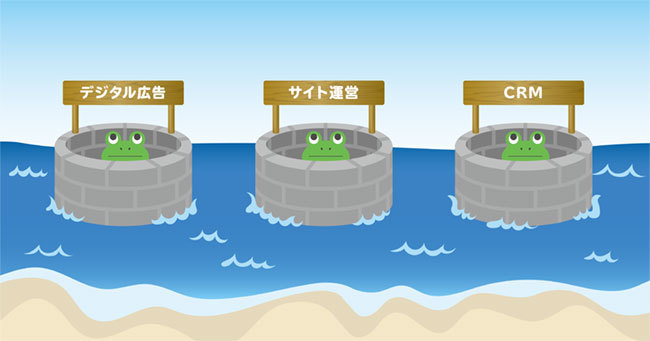
In such situations, the responsibility for pursuing "overall optimization" lies not with the frontline personnel, but with those accountable for the entire marketing and advertising function, such as the CMO. They must eliminate wasteful investment from an overall optimization perspective, thereby increasing the probability of sales growth success.
Furthermore, "disruptive innovation" is indispensable for the next phase of growth. Decisions to "invest" in the next innovation—including budget freed up through efficiency gains from overall optimization—are also tasks for the CMO and similar roles.
That said, developing discontinuous innovations is difficult for frontline staff to tackle alone. Innovation carries high failure risk, and fear of failure often leads to a strong tendency to avoid taking risks.
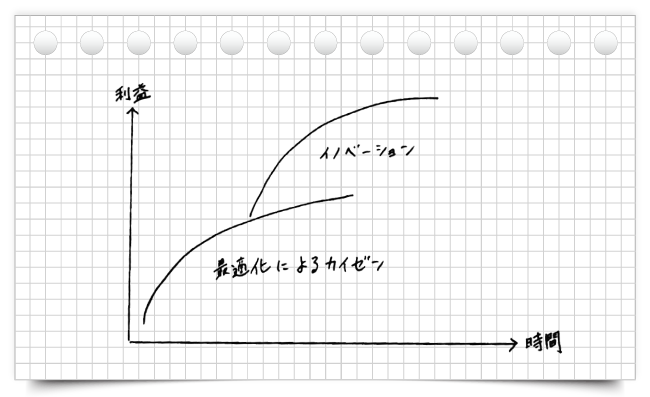
In an unpredictable future, the mindset of "it's okay to fail" leads to innovation that breaks conventional frameworks. In other words, tolerating and encouraging failure at the operational level is also part of the CMO's role.
However, this mindset is only feasible when performance allows. It must be pursued while the company has the strength, achieved through measures like improving digital marketing efficiency.
Ⅲ Four Key Areas for Driving Overall Optimization and Innovation
The following four areas should be considered when driving overall optimization and innovation:
-
People…General consumers, customers, brand fans, etc., whose understanding deepens with richer data
-
Brand… Products and services that continuously improve in quality through digital adoption
-
Integration…Seamless customer touchpoints and experiences that blend digital and physical
-
KPI…Key performance indicators that have become increasingly measurable through digitalization

Incidentally, mapping these four areas to the traditional marketing process framework of "STP + 4Ps" yields the following:
-
People → S: Segment and T: Targeting
-
Brand → P: Positioning
-
Integration→Corresponds specifically to Place and Promotion within the 4Ps
-
KPI→ Thoroughly verify digital effectiveness across the above three domains
Digitalization has made customer-related data more accessible, leading to more sophisticated and granular targeting within the People domain. Furthermore, in the Integration domain, customer touchpoints connecting People and Brand have significantly changed through the seamless fusion of physical and digital channels. As discussed later, these evolving circumstances necessitate rethinking "how brands are built."
Enhancing marketing capabilities and driving brand sales and fan growth requires incorporating digital (data and technology) into the traditional STP + 4P marketing process to promote overall optimization and innovation.
While specific initiatives for each domain will be introduced in subsequent installments, this time we will focus on the perspective of "Brand"— —which is also the theme of this series.
IV. Brand Building in the Digital Age: The "Why Model"
The evolution of digital marketing has made it possible to segment target audiences more finely and implement highly personalized, one-to-one approaches.
Today, it's no longer necessary to start with mass advertising, approaching the entire target audience—including potential customers—from the top of the funnel. In many cases, it's more cost-effective to first use digital channels to target various types of existing customers lower down the funnel with one-to-one approaches.
However, when target segments multiply, the breadth and variety of messages expand, often diluting the core appeal of the brand itself. Therefore, the method for defining brand value also requires re-examination.
Traditionally, brand building followed a "pyramid model" where emotional and functional brand values, along with product/service features, were unilaterally communicated to a master target. However, in the digital era, the "Why model" is more applicable. This approach involves setting diverse target segments while co-creating with the brand a shared "value proposition" or "raison d'être" that resonates with all of them.
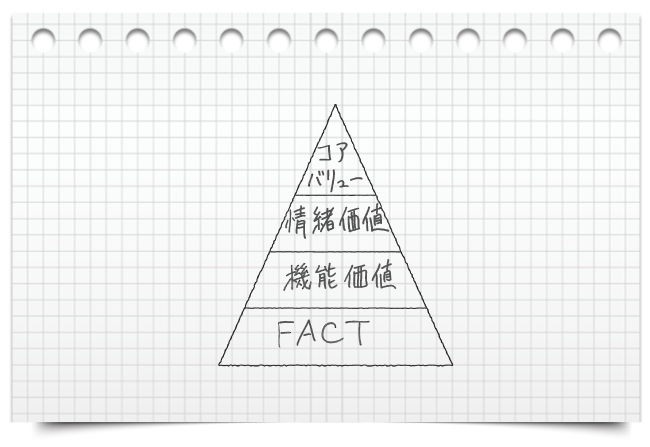
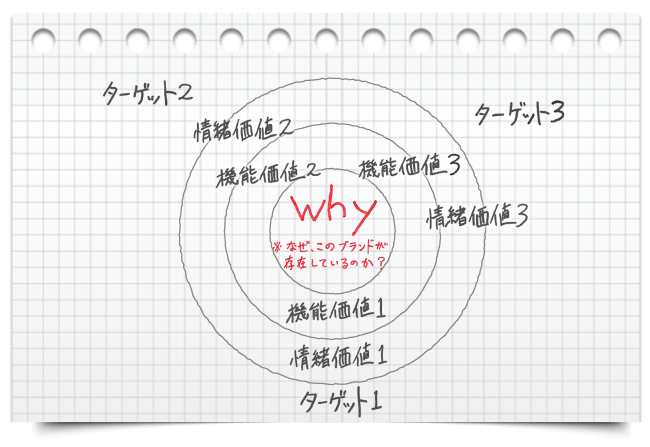
Specifically, while communicating functional value, emotional value, and product/service features from various angles tailored to each target's interests, the core message remains centered on the unshakeable "Why" – "Why does this brand provide such services?" – no matter how many target segments or appeal types emerge.
Taking the automated cleaning robot market as an example, when these robots first appeared in Japan, the main target was "DINKs" (Dual Income No Kids households). However, as work styles, lifestyles, and family structures have diversified, the target audience for cleaning robots has also broadened.
For instance, new targets include "active moms" who value both work and hobbies but also want to thoroughly handle household chores without cutting corners, and "senior couples" whose children have become independent, who have retired, and who have started keeping pets like dogs or cats.
While the "time-saving" appeal remains effective for busy DINKs, the "cleans every nook and cranny" appeal resonates with active moms who strive for perfection in everything. For senior couples with pets, the "effectively removes pet hair" appeal is impactful.
In digital marketing, we can segment markets finely and deliver optimal messages one-to-one. However, competitors do the same, leaving targets unsure which brand to choose.
Amidst this, if a new brand A emerges with a strong purpose ( Why ) like "To value and enrich every family's time, ensuring not a single second is wasted," it has the potential to instantly resonate with diverse families.
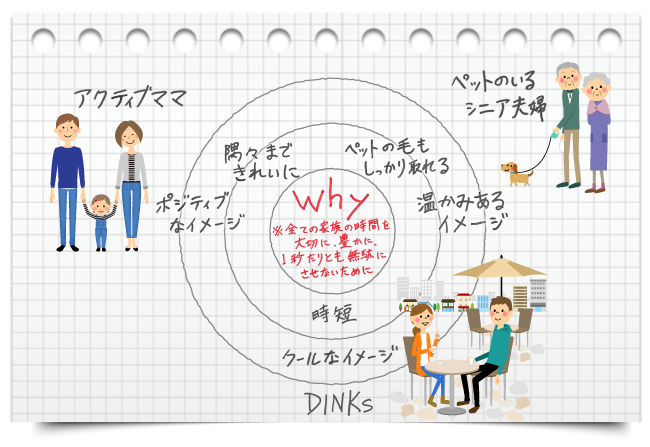
Without this Why philosophy, if it were simply "a product that saves time, cleans thoroughly, picks up pet hair effectively, and is a great deal," this new Brand A would likely get lost in the crowd.
Empathy in the world arises not from "What" it can do, but from "Why" it does it. Designing that brand's unique raison d'être—its "Why"—and considering how to communicate that Why alongside the optimal message for each individual is the job of CMOs and others.
This was one example of the increasingly specialized sessions on People and Brand.
Was this article helpful?
Newsletter registration is here
We select and publish important news every day
For inquiries about this article
Author

Masafumi Tanizawa
Dentsu Digital Inc.
Integrated Planning Division
Business Unit Head / Innovation Director
Joined Dentsu Inc. in 2002. Since then, has participated in numerous president-level projects and CMO projects for various clients. Serves as a director handling both strategy and execution, spanning beyond advertising to include management and business strategy consulting, brand consulting, cutting-edge database marketing, and integrated campaign planning. Holds a Master of Business Administration. Planning motto: "Calculate meticulously, execute boldly!"

